TOTOYA

Another nice wahoo
Most of our sail to Totoya was very pleasant. Although we had not planned to fish our first day underway, we got a radio call from S/V Learjet telling us that they had just caught both a wahoo and mahi-mahi after trolling for only a few minutes. Nita went on deck to ask Bud if he would like to throw in a line, and he was on the aft deck securing the line that he had already tossed in. Within a few minutes we had a nice wahoo, and we put away our fishing gear.
Although we crossed the international dateline heading east, we remained in Fiji’s singular time zone, and we pretended we were still west of 180. Our sail was quite pleasant (particularly considering we were sailing to weather) until we neared Totoya, then it got windy and the seas became bumpy. We hove to for the night to wait for daylight, and it was a somewhat uncomfortable night. After daybreak, we went in the pass through the barrier reef, tucked in behind a corner, dropped a hook, and waited for S/V Learjet whom had held further off than we had. When S/V Learjet cleared the pass, we followed them in to the inner lagoon.
Totoya is a narrow horseshoe shaped island with a surrounding barrier reef. The inner bay is very big. It is roughly circular in shape and about 2 1/2 miles in diameter. However, the entire island is less than 11 square miles of land. Tovu, the village off which we anchored, is on the east side of the bay. Although we circled looking for a shallower spot, we ended up anchoring in 60′ mud a bit too close to the reef. We had to move when the winds shifted.
Cama, the chief’s spokesman who Bud and Glenn had met in Suva, came out to greet us. Bud and Glenn went ashore to make sevusevu with the chief, and they both found him pleasant and welcoming.
We learned that the chief’s ceremony was being postponed for five days – until July 1. We also learned that Bud and Glenn were in high demand to fix things – everything from weed whackers to outboards to generators. So we decided to stay in the inner harbor and work around the villages until the ceremony, then we would leave shortly afterward.
We also learned that Totoya is not as isolated as we had expected. A supply ship – the Tovuto – comes monthly, and they also carry passengers. So former Totoya residents living in Suva can visit the island, and current residents can visit Suva (or beyond). There are, however, no vehicles or roads. And we were told that the children have never seen a bicycle. We considered getting our bikes out to show them, but there were no paths on which we could ride.
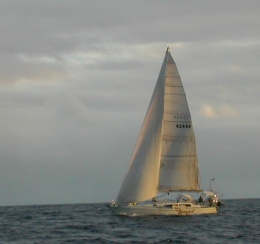
S/V Learjet
good cruising companions
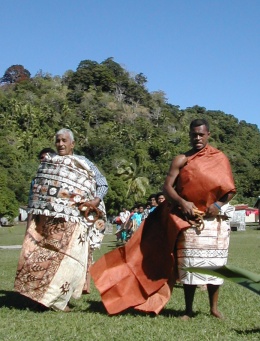
chief & escort procession of villagers behind
Helping the locals is a good way to get to know them, and we took advantage of this opportunity in Tovu and Ketei – the village just north of Tovu. While Bud worked on fixing things, Nita got to know some of the women and learned a bit about their lives. We enjoyed our interactions with them.
Unfortunately, the demands on Bud became a bit overwhelming. He was limited in what he could do lacking parts, but he fixed what he could. But we did not have the time or opportunity to do much else because Bud was being directed from one broken thing to another.
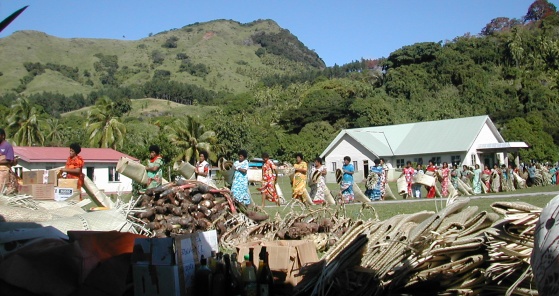
Women in procession behind mounting piles of gifts
Nita had been asked to put together unspecified first aid supplies to give to the health center, and she spent considerable time and money doing this while still in Suva. However, when she toured their health center she found a remarkably well supplied clinic that did not need what she had brought. The nurse kept the supplies nonetheless.
We had other uncomfortable incidents occur that involved requests for money and yanqona. We were feeling a bit taken advantage of.
But Saturday came – the day of the ceremony – and it was wonderful! The chief is a quiet and gentle man, and he seemed somewhat uncomfortable with so much ado on his behalf, but he participated with a quiet dignity.
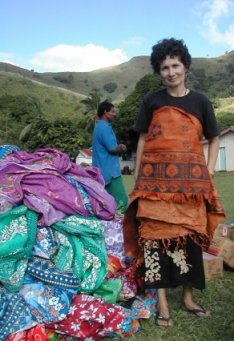
Nita in masi next to a growing mound of fabric
Most of the ceremony itself was gifts being presented to the new chief by groups. There were groups from each of the four villages on Totoya, from some of the surrounding Lau islands, and even from Suva. Gifts were mainly masi (Fiji’s version of tapa), woven mats, coconut oil, kerosene, dalo (Fijian taro), cassava (tapioca root), fabric, pigs, and a cow. He was also given eight whale’s teeth – a Fijian tradition.
Each village would assemble elsewhere and approach the chief in a procession led by their village chief. Each village chief came wrapped in masi which is a traditional display of mourning. The masi was unwrapped from the chief by Cama, and whale’s teeth were presented. Then the following procession would place their gifts on the ground nearby.
The quantities of the gifts were surprisingly large. Each village brought dozens of mats, baskets of vegetables, reams of fabric, etc. We later saw the mounds of gifts being reorganized so that they could be redistributed back to the villages that had brought them. We do not know the rationale for the redistribution, but it was good to see that the massive booty was being shared.
We spent a few hours sitting in the shade drinking yanqona, then we went for a hike up to the school which has a spectacular view. On our way back down the hill we stopped for lunch at the home of one of the villagers. Lunch was another of those priceless local experiences.
But it was time for us to move on. We were anxious to explore the north shore of the island inside the barrier reef, and we wanted to do some diving. We made our farewells with plans to leave the following morning.
We did leave the inner bay on Sunday, July 2. We motored up to a beautiful little bay – Navu Bay – on the north shore and anchored in 35′ of sand. S/V Learjet came in soon afterward. However, despite its beauty, the bay was quite small, and we were uncomfortably close to various bommies. We did a quick dive, and we were disappointed in what we found. There are fish, but the corals appear mostly dead, and they are heavily silted. We also went ashore and explored a very cool abandoned fishing camp, but we remained too close to the bommies. So after only one night there, we went exploring in the dinghy, and we decided to move about a mile east to Vagava Bay. S/V Learjet followed.
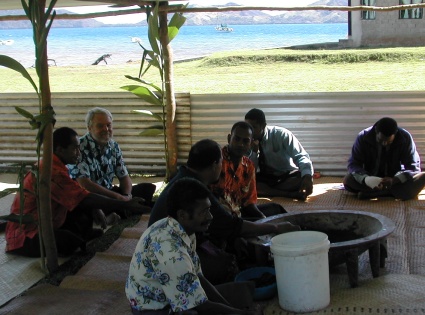
Drinking yanqona

View from the school
Vagava Bay was larger, it had adequate clearings without bommies, and we were able to anchor in 35′ of sand. We did a dive there and found conditions similar to Navu bay with the exception of an occasional isolated healthy appearing bommie, and we found one of those right under our boat. It was covered with anemones, and there were hundreds of anemone fish in them. Hundreds! We were cold after being in the water for 75 minutes, so we surfaced with plans to revisit them with our cameras. However, a northeast swell had come up, and we rolled. Another uncomfortable night. So the following day, in the company of S/V Learjet, we set out in search of a quiet anchorage on the east side of the island.
We motored for over three hours, negotiated some hair-raising minefields of reef, and found nothing. We returned to Vagava Bay, and S/V Learjet went on around the northwest corner to Lawakilevu Bay. We put out our flopper-stopper, and it slowed the roll, but it was still uncomfortable.
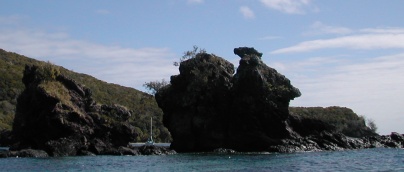
Passage at anchor in beautiful Navu Bay on the north shore
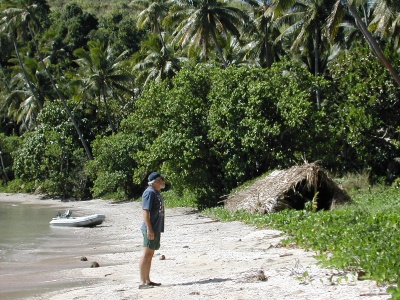
Fishing camp on north shore
We’d had enough. We were ready to head to Moala. We headed off, and we called S/V Learjet on the radio to advise them of our plans. They had damaged their anchor roller, and they could not leave until it was repaired. So we diverted to Lawakilevu Bay to rendezvous with them and help them fix their anchor roller. Fortunately, Bud and Glenn were able to repair it in about two hours’ time. So we planned to sail to Moala together the following day.
Again, we were anchored uncomfortably close to a few bommies, but we had no other options. Then a cold front blew over us with 30+ knots of onshore winds. We had bommies quite close all around us, and the reef along the shore was dangerously close behind us. ‘Uncomfortable’ doesn’t quite describe this afternoon.
We were glad to leave Totoya the following morning. We had spent too much of our time there trying to dodge bommies and run from weather. Although Totoya is a beautiful island, it lacks suitable anchorages for its frequently changing conditions. We finally left on July 6 headed for Moala.